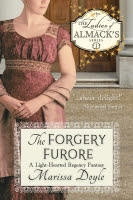Dukes, landowners, gamblers, pirates, and highwaymen. Romances set in early nineteenth century England have a host of intriguing occupations for a dashing hero. But there are three you don’t see so often, and I think you’ll understand why.
Sawyer. Remember, this is a time before the steam-powered sawmill. Loggers might bring down a tree and peel off bark and limbs, but it was the sawyer who cut it into planks and beams for use in buildings. Apparently, a suitable tree was dragged to span a pit or propped up high as in this picture. One sawyer climbed down into the pit, so he was under the tree. The other stood on top of the tree. Starting at one end, they worked a two-person saw up and down, cutting through the wood to create the desired width. The man on top might not have it too difficult, but woe betide the man below, who was shoving a heavy metal blade up over his head constantly. Says A Book of English Trades, published in 1802 to give youths career guidance, “This is a very labourious employment.”
Stocking weaver. Doesn’t sound so terrible, does it? You sat and worked a loom that created wool or silk stockings of all sizes. Unfortunately, there were a few challenges. One, the looms supplanted hand-sewing, replacing skilled labor with unskilled. Some folks took that badly, and, in some cases, violence resulted. For another, the work was long and boring, and you barely made enough to get by. But, notes A Book of English Trades, it was clean work, indoors. There was something to be said for that.
 Ratcatcher. Did I notice a wince? Unlike our tech-savvy exterminators today, ratcatchers in the nineteenth century were more hands-on. While they did wield poison when needed, they were more likely to employ traps and deal directly with the vermin. And the vermin were particularly verminous back then. Remember, fleas from rats have been linked to the plague.
Ratcatcher. Did I notice a wince? Unlike our tech-savvy exterminators today, ratcatchers in the nineteenth century were more hands-on. While they did wield poison when needed, they were more likely to employ traps and deal directly with the vermin. And the vermin were particularly verminous back then. Remember, fleas from rats have been linked to the plague.
So, what do you think? Could you find it in your heart to root for any of these gentlemen as a hero in a romance novel?






2 comments:
I'll take stocking weaver for my hero! We don't have one of those machines in the museum where I work, but I am familiar with the concept. Samuel Slater started out making hosiery and learning to manage a textile mill. He died a millionaire after starting the American Industrial Revolution. Some info from Wikipedia: Richard Arkwright [developed] experimental spinning machinery. He moved to Cromford, Derbyshire and set up what became known as the water frame. [Jedidiah] Strutt, as his partner, set up mills at Belper and Milford. Thus the area joined Nottingham in producing cotton stockings, while Derby, with its mills originated by John Lombe continued largely with silk; Leicester, a farming area, continued with wool."
Well, there you go! Reminds me of Sheri Cobb South's The Weaver Takes a Wife. :-)
Post a Comment